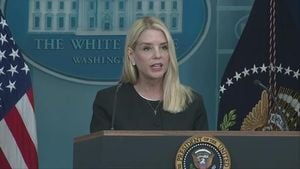On June 27, 2025, the U.S. Commerce Department released the latest data on inflation and consumer spending, offering a nuanced snapshot of the American economy amid ongoing concerns about tariffs and Federal Reserve policy. The Personal Consumption Expenditures (PCE) price index, the Federal Reserve's preferred gauge of inflation, showed a modest uptick in May, signaling underlying price pressures that may shape the central bank's decisions in the months ahead.
The headline PCE inflation rose 0.1% month-over-month in May, matching expectations and the rate from the prior month, while the annual rate climbed to 2.3%, up from 2.1% in April. This increase aligns with economists' projections, but it also moves the inflation rate further away from the Fed's 2% target, raising questions about the trajectory of price growth as tariff effects potentially intensify.
More tellingly, the "core" PCE index, which excludes volatile food and energy prices and is considered a better measure of underlying inflation, rose 0.2% month-over-month in May—slightly faster than the previous month and above economists' forecasts. Year-over-year, core prices increased 2.7%, marking a subtle but notable acceleration. Neils Christensen, a financial journalist, highlighted that the annual PCE inflation for May rose to 2.7%, underscoring this trend.
Despite these inflationary signals, consumer spending showed signs of cooling. Adjusted for inflation, personal spending fell 0.3% in May, a reversal from a slight increase in April. Personal income also declined by 0.4%, the largest drop since 2021, largely due to the unwinding of a spike in Social Security payments in April. The decline in spending was particularly pronounced in categories like automobiles and gasoline, which weighed heavily on overall consumer expenditures—an important consideration given that consumer spending accounts for roughly two-thirds of the U.S. economy.
These figures come on the heels of a surprising weakness in consumption revealed in the first-quarter GDP report, which showed an unexpected contraction. The mixed data has left economists and policymakers grappling with the question of how tariffs imposed by President Donald Trump will ultimately affect inflation and economic growth. So far, the impact has been relatively muted, with price pressures subdued and growth holding steady, but many warn this could change in the coming months.
Ed Al-Hussainy, a global interest-rate strategist at Columbia Threadneedle Investments, described the current data as "basically the best data set you would ask for going into an inflation shock." He anticipates a "very sharp" but "very narrow" inflation surge, tempered by a labor market that remains a "big dampener" on consumer optimism and price pressures.
Federal Reserve Chair Jerome Powell has maintained a cautious stance, emphasizing patience before cutting interest rates. Speaking to Congress earlier in the week, Powell said he wanted to see further indications of muted price pressures in June and July before moving forward with policy easing. This wait-and-see approach reflects the Fed's balancing act amid mixed economic signals and uncertainty over the effects of tariffs.
Powell's stance has not been without controversy. President Trump has repeatedly called for rapid rate cuts to bolster growth, and media reports suggest he has considered replacing Powell in the fall, potentially creating a "shadow" central bank leader during Powell's remaining tenure. Meanwhile, two Trump-appointed Fed officials—Governor Christopher J. Waller and Michelle W. Bowman—have recently advocated for a rate cut as early as July, expressing greater concern about the labor market and the risks of inaction.
The Fed's internal projections reveal a divided outlook. While most officials expect to lower interest rates by about half a percentage point this year, opinions vary widely. Seven of 19 officials anticipate no further cuts, two foresee just one quarter-point reduction, and two others predict three cuts totaling 0.75 percentage points. Traders in federal funds futures markets currently price in the likelihood of the Fed beginning rate cuts in September, followed by at least one more reduction before year's end.
The evolving inflation picture is complicated by consumer sentiment. Data from the University of Michigan indicates improved expectations about future inflation and economic conditions, yet survey director Joanne Hsu cautioned that "consumer views are still broadly consistent with an economic slowdown and an increase in inflation to come." This reflects the uncertainty felt by households navigating a complex economic landscape.
Adding to the complexity, the Canadian economy is also under scrutiny, with its GDP reading for April 2025 due alongside the U.S. inflation data. While the Canadian figures were not detailed in the release, they contribute to a broader North American economic context that policymakers and investors are watching closely.
As the summer unfolds, economists and Fed officials will be closely monitoring how tariff-related price pressures develop. Kathy Jones, chief fixed income strategist at the Schwab Center for Financial Research, noted the delicate position the Fed faces: "If we get a sudden surge in prices in the fall because of tariffs, that's going to be a really, really difficult thing for the Fed to ‘look through.’"
In the meantime, gold prices have remained relatively steady below $3,300 an ounce, even as annual PCE inflation rose, reflecting cautious investor sentiment amid the economic uncertainty.
All told, the latest inflation and spending data paint a picture of an economy at a crossroads. Inflation is nudging upward, but consumer spending and income are softening. The Federal Reserve finds itself in a challenging position, balancing the risks of rising prices against the need to support growth without stoking financial instability. With tariffs looming as a potential wildcard and mixed signals from the labor market, the months ahead promise to be a critical test for U.S. monetary policy and economic resilience.




